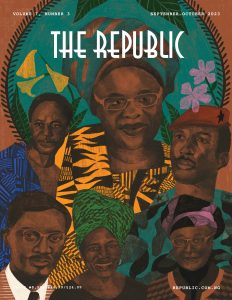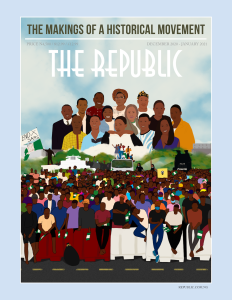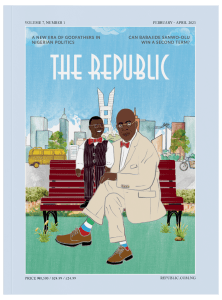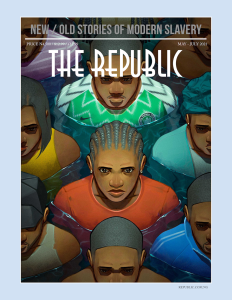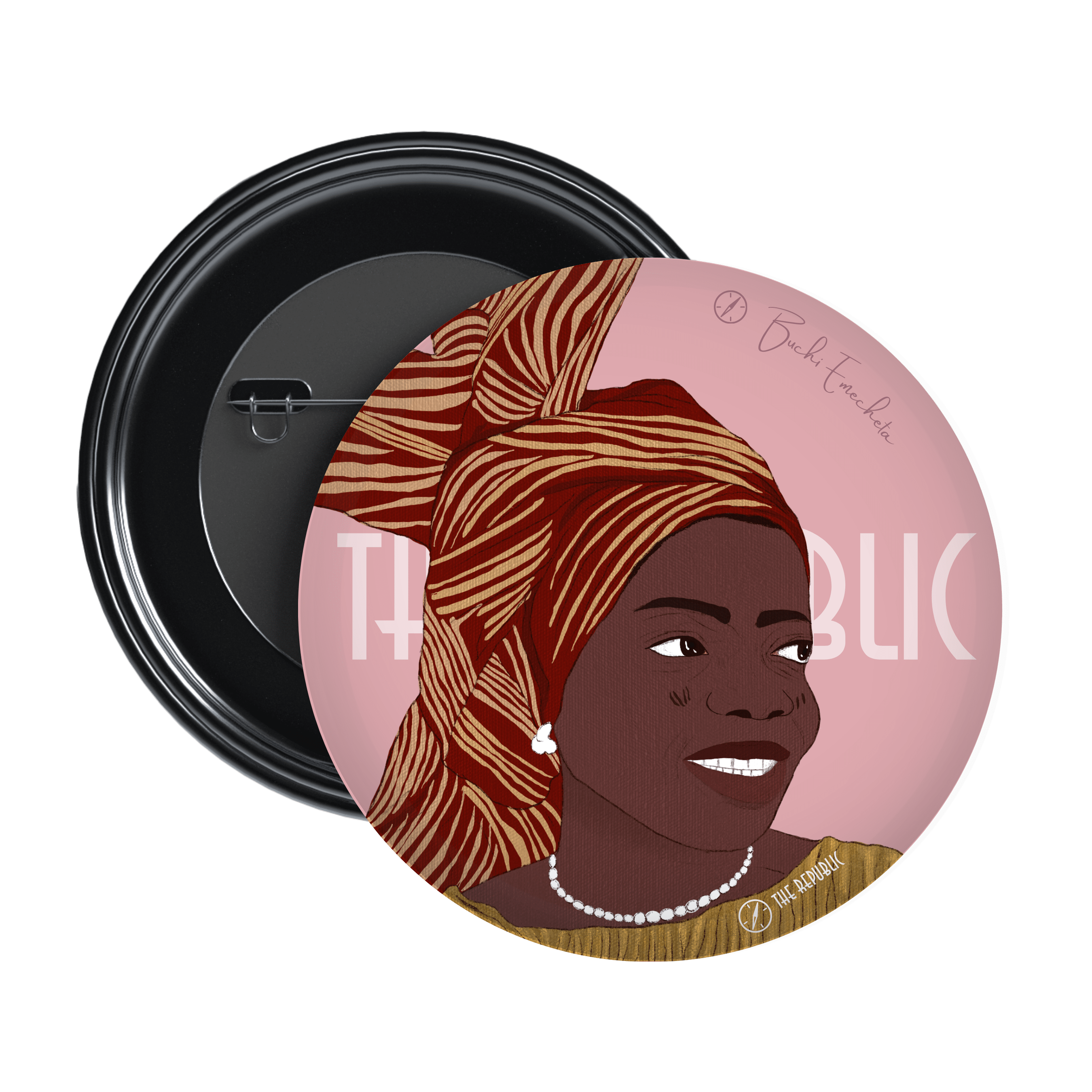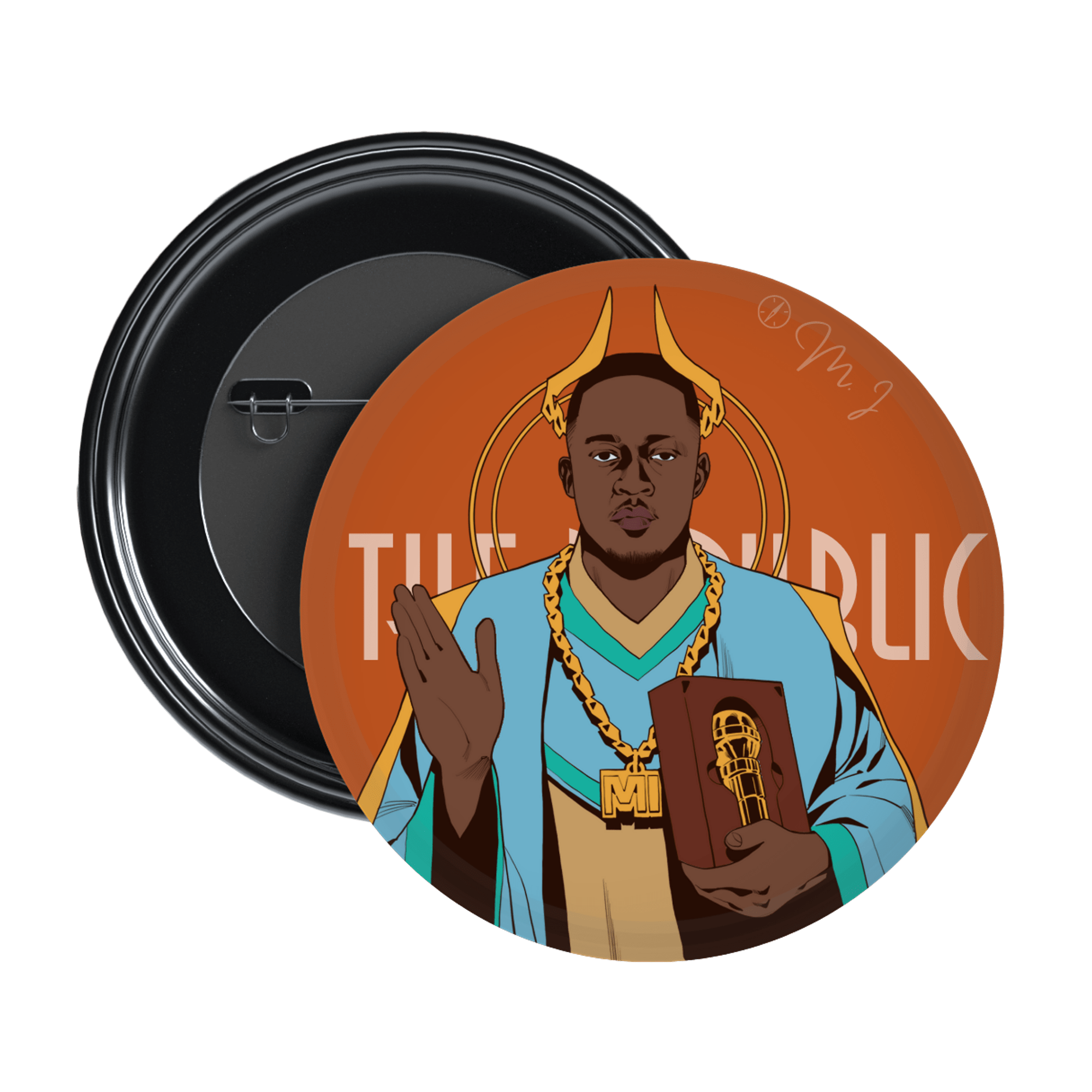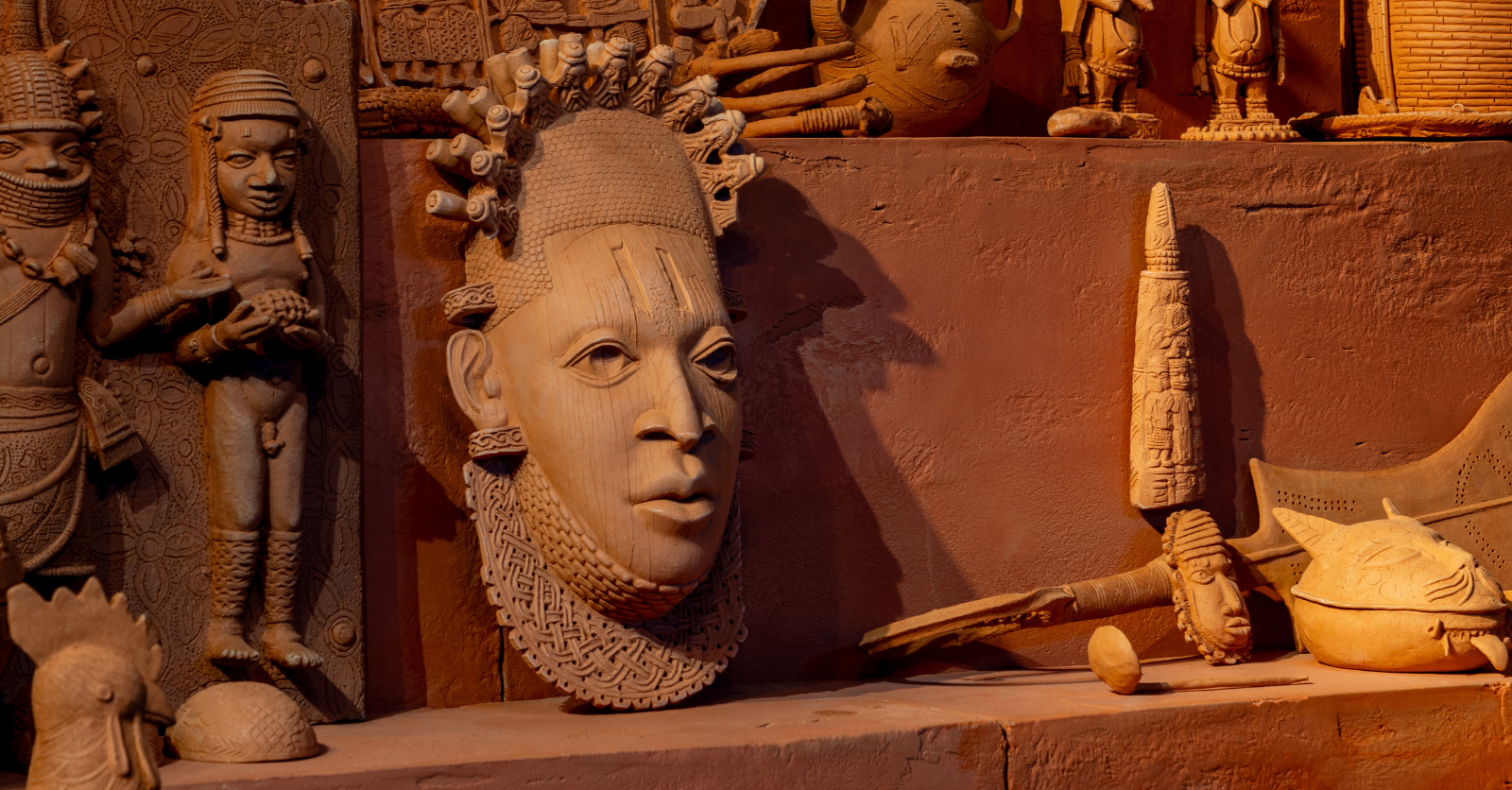
Yinka Shonibare CBE RA, Monument to the Restitution of the Mind and Soul, 2023. Installation view, Nigeria Imaginary at the Nigeria Pavilion at the 60th International Art Exhibition — La Biennale di Venezia. MARCO CAPPELLETI STUDIO / MUSEUM OF WEST AFRICAN ART (MOWAA).
the ministry of ARTS / VISUAL ART DEPT.
Yinka Shonibare and the Case for Nigeria at the Venice Biennale

Yinka Shonibare CBE RA, Monument to the Restitution of the Mind and Soul, 2023. Installation view, Nigeria Imaginary at the Nigeria Pavilion at the 60th International Art Exhibition — La Biennale di Venezia. MARCO CAPPELLETI STUDIO / MUSEUM OF WEST AFRICAN ART (MOWAA).
the ministry of ARTS / VISUAL ART DEPT.
Yinka Shonibare and the Case for Nigeria at the Venice Biennale
Nigeria’s second showing at the 60th Venice Biennale seems to be a resounding success. Global commentary and criticism have largely praised the curatorial vision and imagery on display. For instance, a critic for The Guardian says of the pavilion, ‘There’s a real sense here of creative ingenuity, material complexity and dialogue.’ Writing for Le Monde, another critic names the Nigerian pavilion among one of the ‘most interesting’ pavilions at the Biennale. And in a telling observation, a New York Times critic notes that upon visiting the Nigerian pavilion, they found visitors taking selfies in front of every artwork, and no customized tote bags left due to the pavilion’s popularity. ‘At this year’s event, the bright green tote from the Nigeria pavilion seems to be the one that everyone wants.’ Naija no dey carry last.
Nigerians might be markedly less surprised than global commentators about the rave reviews. Nigeria has always seemed to occupy an outsized place in the cultural economy, producing innumerable icons and works of note. Big shoes for any curator to fill. But Aindrea Emelife’s pavilion, Nigeria Imaginary, has proven to meet the task and perhaps surpassed it. For the 60th Venice Biennale, Emelife is asking questions about Nigeria’s potential future. Nigeria Imaginary is positioned, she says, as a constellation of ‘a multitude of ideas, memories and nostalgias of the country boosted by a deserved criticality to enable dreaming.’ In an interview with The Republic’s editor-in-chief, Wale Lawal, Emelife explains that many of the artists featured ‘take moments from history as starting points, sitting within these imagined pasts to consider new configurations of both the past and the present.’
For the pavilion, Emelife selected eight artists, only one of whom currently resides in Nigeria. Forecasting raised eyebrows at this choice, Emelife, a young Black woman in the art industry—a positionality that Western institutions have routinely been criticized for underrating—issued a pre-emptive explanation. Speaking to the New York Times, she highlights migration and leaving as integral parts of the Nigerian experience: ‘People are always leaving, and that’s important to articulate with presenting Nigeria as a place.’ Against the backdrop of today’s ongoing Japa wave, this is increasingly true. There is perhaps also a more pragmatic curatorial reason for this. Adriano Pedrosa, curator of this year’s Biennale, has noted that his Biennale is one for artists who are themselves foreigners, immigrants, expatriates, diaspora, émigrés, and refugees, as well as those who are outsiders in other senses. In choosing to have some of the Nigerian pavilion’s contributors be of the diaspora. Emelife nods to this overarching vision while positioning Nigerian art as necessarily transnational and potentially even post-national—that is if we think of the nation only in essentialist terms.
ROUTES, NOT ROOTS
Among the eight artists in Nigeria’s pavilion, the choice of Yinka Shonibare CBE RA points sharply to a different way of conceptualizing the national imaginary and the aesthetic choices that might represent it. Shonibare is strikingly diasporic, an artist who is constantly moving between Nigeria and elsewhere. The British-Nigerian, Nigerian-British artist was born in London and moved back to Lagos with his family where he spent the entirety of his childhood. Other than his summer holidays, he would not return to London until he was 17, to resume his art education at the Byam Shaw School of Art and later Goldsmith’s. At 18, he contracted transverse myelitis, a disorder caused by inflammation of the spinal cord which has resulted in the long-term paralysis of one side of his body. In a 2013 Guardian article, he notes ‘I had no movement at all from the neck down, so I had to work very hard to trick my brain into making parts of my body work. I still have residual paralysis and I use a wheelchair.’ Across many interviews, he notes that he has never wanted his disability to serve as a barrier to his art practice. A quick read through his long and accomplished CV proves it has not.
A superficial reading of Shonibare’s biography might suggest an irresolute placelessness: born in London, raised in Lagos, works now across multiple major cities in the West, but with strong present-day links to Nigeria. However, Paul Gilroy’s emphasis of routes as opposed to roots in his widely read The Black Atlantic, opens a different geographical front and way of understanding place. Gilroy’s work notably rejects essentialist constructions of identity that attempt to locate Blackness in fixed and unmoving time-spaces. Gilroy instead seeks to trace Black cultural formation through hybridity and creolization across and through the triangle that represents the slave trade routes, from West Africa, to Europe, and on to the ‘New World’. Through Gilroy’s work, we might understand the Black body as borderless.
The 2018 Pitzhanger lecture puts Shonibare and Gilroy in direct conversation. The three-part lecture features many rich contributions worth probing, one of which is Shonibare’s experiential encounter with ‘double consciousness’, a concept Gilroy borrows from W.E.B. Du Bois. Speaking about the challenges of identity as a Black artist creating in an anti-Black world, he pithily observes, ‘It occurred to me that if you made work about being Black you would be the Black artist who makes work about being Black, but if you didn’t make work about being Black you would be the Black artist who doesn’t make work about being Black.’
Shonibare’s realization here is one that feels almost universal to the Black cultural worker experience. It is, however, also quite specific to him. While studying at Byam Shaw, Shonibare was confronted by his white British tutor. A New York Times article describes the encounter in Shonibare’s words. ‘Why are you making work about Perestroika,’ Shonibare had been asked. ‘Why don’t you make authentic African art?’ Shonibare was at first perplexed. What did authenticity mean? What would it look like?
shop the republic
-
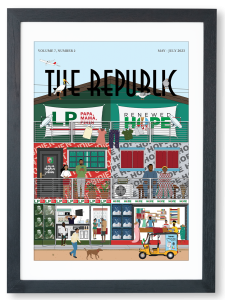 ₦70,000.00 – ₦75,000.00Select options This product has multiple variants. The options may be chosen on the product page
₦70,000.00 – ₦75,000.00Select options This product has multiple variants. The options may be chosen on the product page -
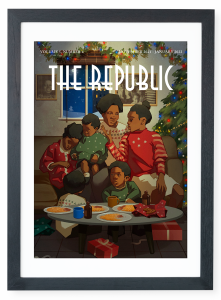 ₦70,000.00 – ₦75,000.00Select options This product has multiple variants. The options may be chosen on the product page
₦70,000.00 – ₦75,000.00Select options This product has multiple variants. The options may be chosen on the product page -
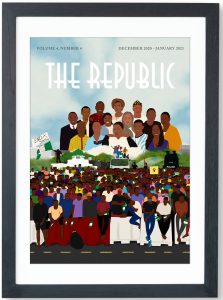 ₦70,000.00 – ₦75,000.00Select options This product has multiple variants. The options may be chosen on the product page
₦70,000.00 – ₦75,000.00Select options This product has multiple variants. The options may be chosen on the product page -
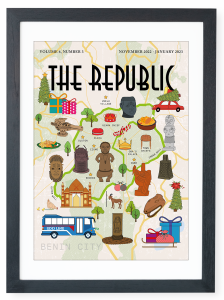 ₦70,000.00 – ₦75,000.00Select options This product has multiple variants. The options may be chosen on the product page
₦70,000.00 – ₦75,000.00Select options This product has multiple variants. The options may be chosen on the product page
shop the republic
-
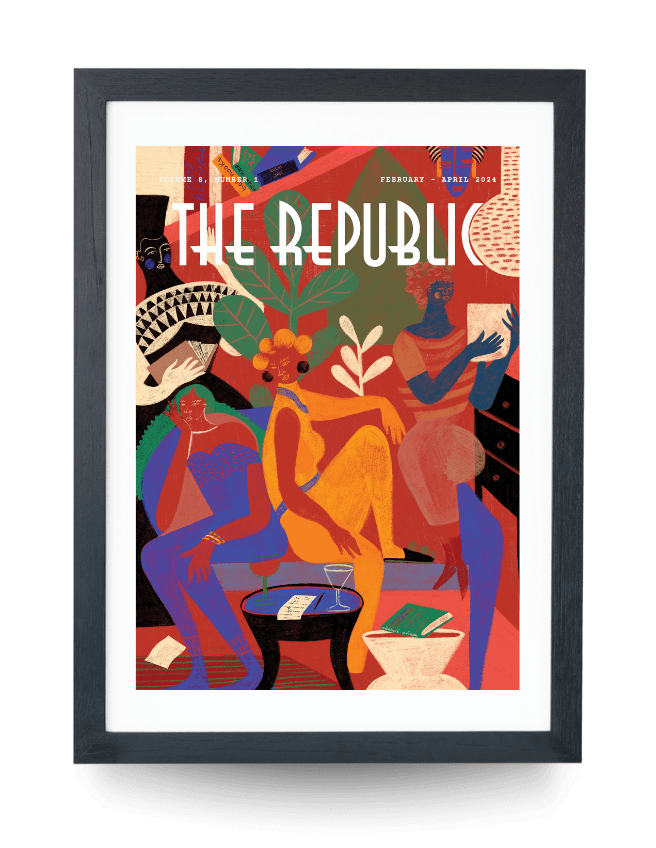 ₦70,000.00 – ₦75,000.00Select options This product has multiple variants. The options may be chosen on the product page
₦70,000.00 – ₦75,000.00Select options This product has multiple variants. The options may be chosen on the product page
Many of us engaged in cultural production abroad deeply understand this quandary. Where our white counterparts are allowed the freedom to borrow, be inspired, or even steal from anyone, we must constantly respond to questions about where we come from and what is ‘our place’. Our writing and art are expected to serve as a readymade map to our roots and our imbrication within them. And so, we become doubly conscious of ourselves and of white societies’ attempts to place us and fix us in a neatly defined and unchanging locale.
Shonibare’s work to resolve these questions progressed in many ways with a refusal of them. His answer came in the form of ‘African fabric’ or what is colloquially referred to as ‘ankara’ fabric. These Dutch wax prints we consider to be deeply African were actually an industrial imitation of Javanese prints crafted by Dutch merchants in the 19th century to penetrate the Indonesian market. While Dutch wax failed to meet its initial goal, it gained traction in West Africa and over time integrated itself into African apparel. Today, it has gained a cultural association with Africa. Shonibare was tickled by the lineage of the fabric and chose to make it a core part of his artistic practice. While the fabric is largely understood to be authentically African, its history shows it to have originated elsewhere.
Further, the fabric, while refusing an essentialist attempt to be placed, gestures towards routes, and the different cultural interactions that unfurl along them. It is the accumulated layers of these shifting, hybrid, and interconnected moments of encounter that lead to different cultures. By taking it up, Shonibare can play with foisted expectations of authenticity while simultaneously critiquing them.
His refusal to be placed by questions of authenticity extends beyond his choice to centre ankara fabric in his art. Many of his pieces feature solid colour mannequins in order to suggest racial ambiguity. In his 2008 series of images titled The Sleep of Reason Produces Monsters, Shonibare reworks an eighteenth-century etching by Francisco De Goya to represent different continents. For Africa, he features a white model, for Asia, a Black one and so on. The tensions at play in the choice of model and the continent they represent is the point. Here, and across his oeuvre, Shonibare refutes stereotypes and exploits our expectations. In demonstrating his rationale, Shonibare told BOMB Magazine in 2005, ‘It’s natural for people to want to be sectarian or divisive. Different cultures want to group together, they want to stick to their own culture, but what I do is create a kind of mongrel.’ The mongrel as medium becomes the message.
What does this mean for Nigeria, a nation that is constantly roiling across its own divides? Given the increasing size and proliferation of Nigeria’s diaspora, there is much to be said in favour of understanding Nigeria’s culture in terms of routes and not just roots. Recent debates about Nigerian literature point to a need for a more elastic framework that transgresses borders. As well, an honest reading of our history points to a Nigeria whose chimeric nature refuses to be easily placed.
In choosing to showcase Shonibare’s work amongst other diasporic contemporaries—London’s Onyeka Igwe and Tunji Adeniyi-Jones; New York’s Toyin Ojih Odutola; and Precious Okoyomon; Florida’s Fatima Tuggar; and Toronto’s Abraham Onoriode Oghobase—as integral to the ‘Nigerian imaginary’ on a stage like the Venice Biennale, Emelife seems to upend an understanding of authentic Nigerian art and culture as that which derives from a fixed time and place. What makes Nigerian art ‘Nigerian’ becomes, instead, more fluid. What places this art piece or that art piece within the Nigerian canon is read, alternatively, alongside considerations of how various paths, histories, and conjectural forces have given rise to our contemporary cultural moment. Given our ongoing struggles with tribalist bigotries and religious squabbles, choosing to centre art that rejects essentialist judgements feels integral to our continued wellbeing. If we are to do that seriously, then artists like Shonibare mark the groundwork for such an understanding.
shop the republic
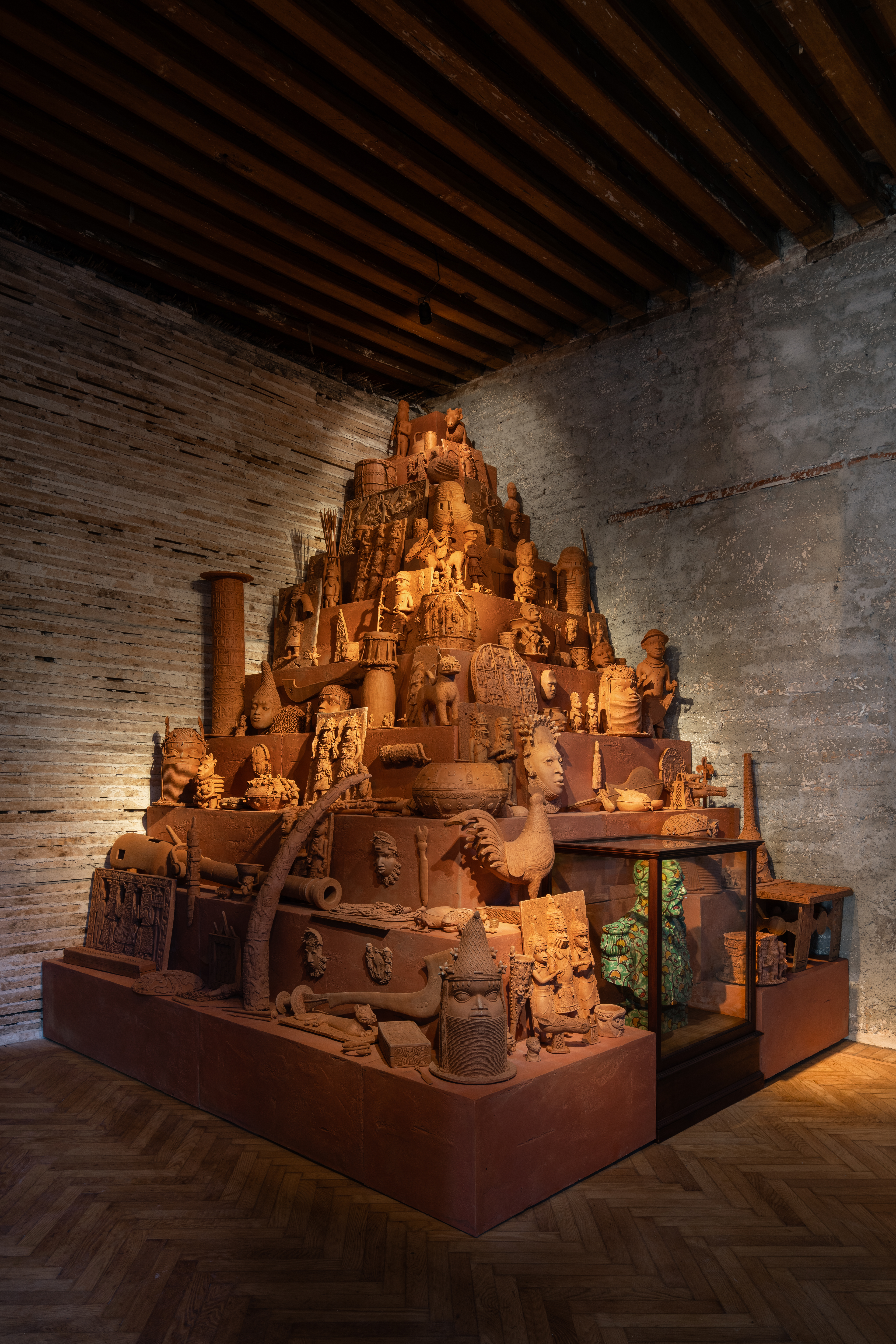
RECOGNITION AS RESISTANCE
Nigeria’s successes at the Biennale aside, there are serious questions viewers might ask about our choice to participate in such an endeavour at this juncture. Given how hard life is for the Nigerian everyday person today, viewers may wonder, are our efforts not better expended elsewhere? National pavilions require money, money that, some could argue, might be needed elsewhere. Others might point out that the Venice Biennale is an event that is inaccessible to all but the most privileged Nigerians i.e., those not bound by either limited capital or a restricted passport. Might the entire exercise not then be rightfully dismissed as a performance for the Western gaze? This particular point binds even this essay. For it, I am drawing entirely on digitized sources, and in fact, most reviews of the Nigerian pavilion will be written by non-Nigerians.
As well, despite the above noted benefits that having a mostly diasporic pavilion affords us—namely that it expands our understanding of what is Nigerian, such a choice still platforms a specific set of sensibilities and concerns. One of the outcomes of such a choice is that Nigeria Imaginary speaks with a singular socioeconomic voice, one that is relatively privileged. Even this article is not outside such power relations. I am after all a Nigerian writer living in the diaspora attempting to make sense of Nigerian art. The selection of my voice for such a task could be critiqued as privileging Western and diasporic inflected perspectives.
There are of course answers to some of these questions. Notably, this year’s Biennale appears not to be funded through Nigeria’s depleting coffers but by private sponsors. In particular, we have Qatar Museums, Arijiju in Kenya, and the Museum of West African Art (MOWAA) among those to thank for this year’s showing. MOWAA also intends as well to bring the entire show back to Nigeria for viewing at its forthcoming Rainforest Gallery in Edo State. Nigerians might not get first crack at the viewing, but they will get an opportunity to see the work in person.
The question of socioeconomic privileged voices is a tougher one to resolve. Almost all of Nigeria’s cultural luminaries eventually interface with the rest of the world and spend part of their lives elsewhere once given the opportunity to. An uncomfortable fact or not, Nigeria’s current, local cultural infrastructure is rarely sufficient for sustaining the sort of growth and opportunities its most ambitious creators desire. Expecting the visual arts to be remarkably different in this regard would be an unfair expectation. Which doesn’t defang the critique, only helps situate it.
As Eric Otieno Sumba argues in Frieze, Nigeria like the rest of Africa is in the world. Notions of an Africa/Nigeria ‘to the world’ suggest a colonial distance between Africa and the rest of the world. One that posits a continent plaintively making the case for its contributions to the rest of the world’s countries. Nigerian artists must be able to make a living, and many of them choose to do so by participating in the global market. Venues like the Venice Biennale for all the high-minded talk of ‘envisioning futures’, ‘critiquing institutions’ and ‘subverting structures’, are also an unparalleled stamp of approval with major monetary implications. An unnuanced refusal to participate would be seen by many as throwing the baby out with the bathwater.
There is much to be said about refusal, especially now in this moment where the global stage is dominated by a concerted abrogation of our responsibilities to one another. Some of us might demand such a shibboleth as proof of moral integrity. The question remains, is it possible to participate in the Biennale while at the same time refusing the structural power relations that underpin it? If we were to attempt such a thing, then we might be hard pressed to find a better ambassador than Yinka Shonibare CBE RA. Shonibare positions his work as anti-colonial and anti-imperialist, yet he uses the post-nominals ‘CBE’ referring to the royal honours first bestowed in 2004, and 2019. He has described his relation to being a Commander of the British Empire as that of a Trojan horse that seeks to resist from within the institution. Rather than reject the honour as an imperialist legacy, Shonibare takes up a different tack and raises a different set of questions. What does resistance look like from within the belly of the beast? How do we respond to resistance that looks unorthodox and challenges our notions of how to engage structural power relations?
If you want a high priest of African art bristling with holy anger at global anti-Blackness, you might struggle to find that in Shonibare’s practice. ‘I had nothing to be angry about,’ he told the New York Times, mid-2009, of his coming of age in 1980s London while living comfortably in his parents’ home. In that profile, the New York Times chose to frame him in contrast with the ‘Afro-Caribbean BLK Art Group, whose fierce work protested the perceived racism of the British art world,’ during that same period, noting that Shonibare ‘felt no kinship with them’. A sentiment that he underscored in 2016 with an argument that people only become defensive when faced with an angry artist shouting at them. ‘That never actually works.’
Shonibare’s style is often praised by Western critics for its prioritized motifs of whimsy, play, elegance, and beauty, often against contemporaries who are framed as being more interested in making shocking or pointed critiques. A 2009 New York Times interview takes care to note his claim, ‘I don’t produce propaganda art,’ adding, ‘I’m more interested in the poetic than the didactic.’ Later in that article, his interviewer observes him telling his studio manager in preparation for a tragic piece, ‘I don’t want to be too obvious. No blood or anything.’
Reading this article, in isolation, presents an image of Shonibare as squeamish or superficial. The trick of course, is to reject such a binary. As Okwui Enwezor, the late Nigerian curator, pointed out in relation to his vision for the 2015 Biennale, ‘There’s always a misunderstanding, as if the socio-political cannot have aesthetic authority, cannot be experiential and powerful, engaging and enduring.’ The question then isn’t whether Shonibare’s work is either beautiful or political. But rather how beauty and politics can intertwine to offer a critique that is unexpected.
A critical 1997 essay on Shonibare’s practice by Enwezor helps us see how Shonibare’s work occupies both notions simultaneously. The essay aptly titled ‘The Joke Is On You’, points to how Shonibare presents a carefully engaged critique, reflection and elegance threaded with humour. In a 2021 conversation with Shonibare, designer Yinka Ilori underscores the disarming impact of such an approach: ‘I think [Shonibare] lures us in so we become engaged, so you want to know more and leave feeling a different way to how you walked in.’ In other words, Shonibare’s earlier comments on the futility of caustic anger within art should not be understood as a simultaneous repudiation of the need for critique or protest. If anything, it hints at an approach that is subtle, a barbed needle poking at an audience’s conscience from beneath yards of elegantly draped batik fabric.
Often the problem with shibboleths is that they assume there are only two camps, two options, one or the other. Sometimes this is useful. Other times it gets in the way.
shop the republic
REPATRIATION AND RETURN
Of the images that emerge from this year’s pavilion, the assemblage of Shonibare’s 150 painstakingly recreated clay objects feels the most ‘authentically’ Nigerian. A choice that feels striking given his ongoing refusal of such a label. They appear this way because the objects are facsimiles of historic pieces looted from Benin City in 1897. Objects rendered in a style that has become indelibly and inextricably linked with Nigeria’s global aesthetic and image. Arranged in a relational whole that seems reminiscent of a shrine, Monument to the Restitution of the Mind and Soul suggests both pointed protest and haunted memorial. As facsimiles though, the works both draw a relation to a lost heritage deemed authentically Nigerian, while gesturing to how these qualities lay beyond our grasp.
As his contribution, the piece points as well to the unique quandary of the pavilion’s nominal sponsor, MOWAA. The Museum was set up as an infrastructural response to the ongoing charge that postcolonial states are incapable of responsibly holding their repatriated art. As of 2020, it was intended to signal seriousness on Nigeria’s part that Nigeria was thinking about how it would caretake the returned art. Almost half a decade later, and the West has moved on to other excuses. Shonibare’s piece seems to be pulling this historical context into full display, as a mirror to Western hypocrisy. Especially given the artist’s noted comments on repatriation. In 2022, he told The Nation, ‘I think it is a very positive step to return those stolen artefacts. Yes, I am in support of the return of the artefacts to Nigeria.’
Monument to the Restitution of the Mind and Soul then serves as a compass oriented toward a horizon of return, against the West’s imperial refusal to fully live up to its promise of repatriation. Where Shonibare’s recreations of looted art pieces reveal a desire for a repatriation that might take more time to resolve, his recent attempts to found new centers for arts education in Nigeria hint to a different sort of repatriation—one that he is urgently moving toward. Against the flow of young Nigerian creatives fleeing Nigeria as fugitives, émigrés, newly coalesced diasporic subjects, Shonibare’s efforts focus on using his acquired skills and knowhow to build infrastructure capable of holding the dreams and alternative visions for the next generation. He told The Nation as much at the inauguration of his artists’ center in 2022, ‘we are working with the local community, whilst opening doors for the next generation, equipping them to thrive not just survive.’
Other than his attempts to build new thriving institutions, Shonibare’s work points to an ongoing return to Nigeria again and again within his practice. Even in his early work which a superficial reader might engage with as ‘British’, Nigerian sensibilities lurk beneath the surface. Take his 2001 film, The Picture of Dorian Gray, for example, in which ‘a black man plays within an upper-class nineteenth-century setting,’ as a deconstruction of social relations of power. It is ostensibly about the work of Oscar Wilde, a noted British writer. In a 2005 interview with BOMB Magazine about his practice, Shonibare describes being influenced by Roland Barthes’s Mythologies to ask questions about how art is constructed, and how representation is itself fiction. Elsewhere in that same interview, Shonibare describes a ‘dark side’ to the beauty and the visual excess in his work. The onslaught of sensations and gorgeous details present in Shonibare’s art while quite intricate, elaborate, and spectacular, is not the point, or at least is not the only point.
Reading this interview, I find myself thinking about Nigerian cultural sensibilities of excess and humour as critique. The Picture of Dorian Gray while sounding foreign, becomes also hauntingly familiar. Is this not the reality of our political class? An absurd theatrical production of actors endlessly attempting to re-enact colonial power and recreate its power dynamics on a larger societal scale rather than heal? Who better than us understand excess as a mask? The swaggering of a deeply traumatized nation? We are after all a people who vibe through misfortune, concocting bigger and more elaborate jokes in which we are the punchline, and holding that up to veil our pain, our desperation, our anger at the conditions in which we find ourselves. If any people on this earth have perfected cultural excess to hide dysfunction and breakdown, I am hard-pressed to believe it could be anyone other than us Nigerians. And through it all, we know that the Nigerian joking about police brutality, crumbling infrastructure and the plunging naira, is not just asking you to laugh with them but also to bear witness to the madhouse that is their life. The joke is not the point, or at least, it is not the only point.
Where Ndidi Dike’s critique of police brutality is on its face more transparent about its protest—she features images from the #EndSARS protests in her pavilion contribution—Shonibare’s work hearkens to a different tradition of Nigerian critique that telegraphs its protest in a roundabout way. Shonibare’s larger oeuvre of work embodies this tradition. His works often appear to bury the punchline under yards of fabric and mannequins posed in gorgeous lines while refusing to let himself be placed in any one moment. It could be said that the choice of Shonibare for the Nigeria pavilion allows us to present a Nigeria that is more about routes than roots. A Nigeria that diagnoses its struggles with intricately imagined jokes while holding up a mirror to structural violence and broken promises. And a Nigeria that allows its children to return again and again in an ever-expanding array of visions and alternative futures. As Emelife observes none of us can remove ourselves intrinsically from Nigeria. Even in the diaspora, Nigeria finds us again and again.
There might be something haunting in this last note, many of us after all are trying to escape. But I choose to think of it as comforting, a horizon that never fades from view⎈
shop the republic
BUY THE MAGAZINE AND/OR THE COVER
-
 ₦10,000.00 – ₦30,000.00Select options This product has multiple variants. The options may be chosen on the product page
₦10,000.00 – ₦30,000.00Select options This product has multiple variants. The options may be chosen on the product page -
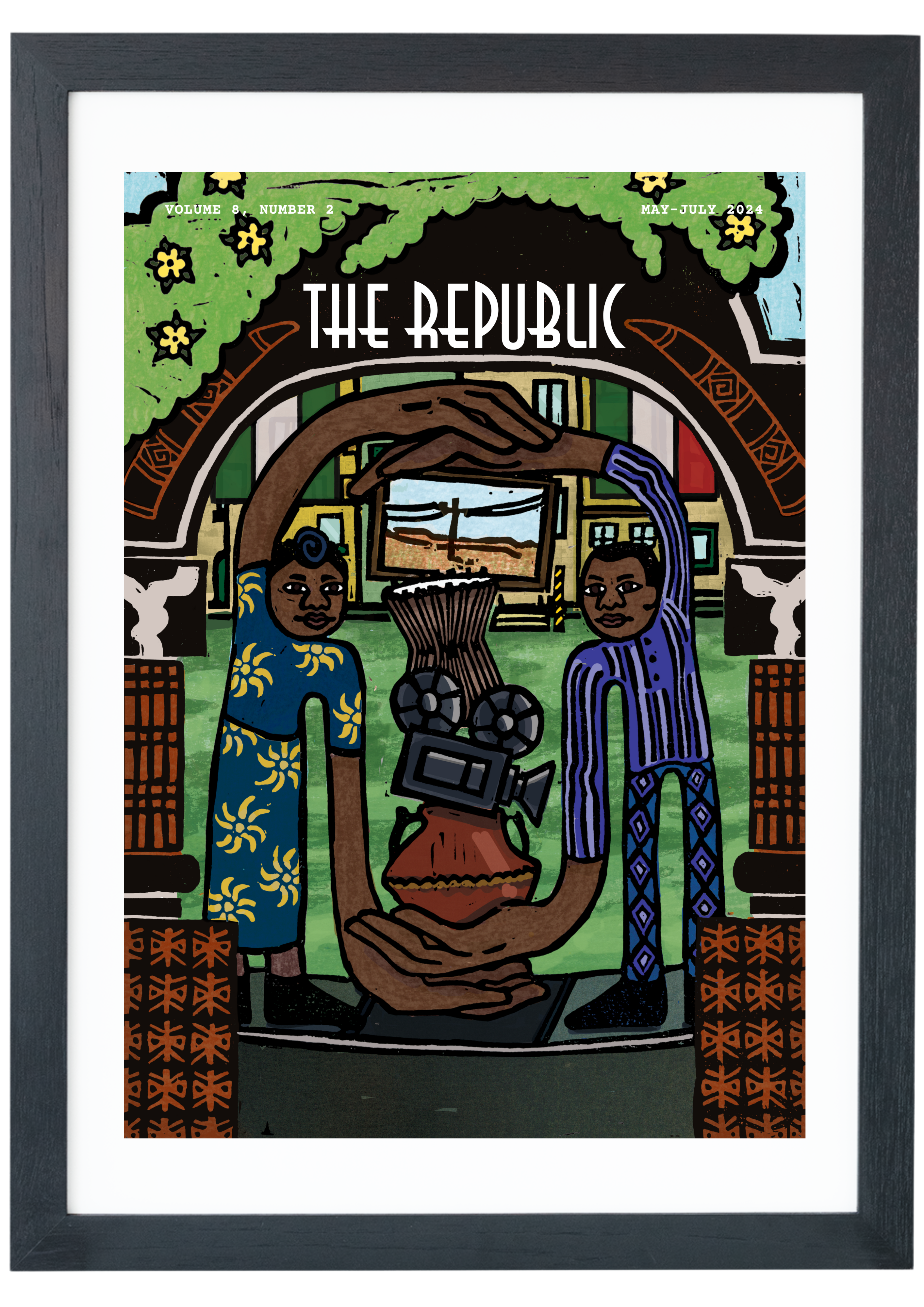 ₦140,000.00 – ₦150,000.00Select options This product has multiple variants. The options may be chosen on the product page
₦140,000.00 – ₦150,000.00Select options This product has multiple variants. The options may be chosen on the product page




